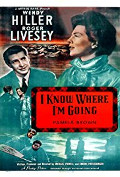
Directed by
Michael Powell / Emeric Pressburger
91 minutes
Rated G
Reviewed by
Bernard Hemingway

I Know Where I'm Going!
If you like the quintessentially British style of Michael Powell and Emeric Pressburger, I Know Where I'm Going! will be a treat. If not, it may not be the most immediately appealing of introductions but so many of the team’s characteristic mannerism are evident – the cinematic craftsmanship, the documentary-like concern for the specifics of landscape and local culture mixed with high-minded romanticism with its pure-hearted hero and high strung heroine, the whole thing wrapped in an overall sense of contended self-satisfaction cut with a knowing irony, a blend which gave their work an unique character.The film was made at the end of WW2 and shot on location in the outer Hebrides by P & P’s regular cinematographer, Erwin Hillier, in one exquisite black-and-white frame after another. The story concerns a self-possessed young woman (Wendy Hiller) who is heading to the island of Kiloran off the coast of Scotland to marry the wealthy scion of a chemical manufacturer. Joan knows where she is going until she meets the pipe-smoking, kilt-wearing laird (played by P & P regular, Roger Livesey) who with his wise charm causes the earth to move beneath her feet.
The opposition between the pretensions of the vacuous well-to-do and the home-spun appeal of simple country folk in harmony with Nature or the appeal of direct plain-speaking individuals (represented by Pamela Brown, then Powell’s lover as Catriona and C.W.R. Knight as Colonel Barnstaple) is driven home with typical P & P relish. Subtlety was not P & P’s strong point but I Know Where I Am Going! is a strong example of what they were good at, the closing scene which equivocally presents the lovers' union as one of being chained together, a fine example of the team's double-edged wit.
FYI: Testifying to Powell’s skill as a film-maker, Livesey, who was appearing in a play in London during the entire filming never set foot on location. Instead Powell used a double for exteriors or shot exteriors just outside London. The result is seamless.
Powell’s first major film, The Edge Of The World, 1937, was also set in The Hebrides.
Want something different?





